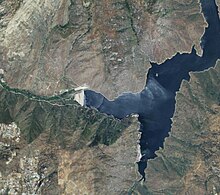El Capitan Dam
| El Capitan Dam | |
|---|---|

Satellite view
|
|
|
Location of El Capitan Dam in California
|
|
| Country | United States |
| Location | Cleveland National Forest, San Diego County, California |
| Coordinates | 32°53′02″N 116°48′34″W / 32.88389°N 116.80944°WCoordinates: 32°53′02″N 116°48′34″W / 32.88389°N 116.80944°W |
| Owner(s) | City of San Diego |
| Dam and spillways | |
| Type of dam | Embankment |
| Impounds | San Diego River |
| Height | 237 ft (72 m) |
| Length | 1,170 ft (360 m) |
| Reservoir | |
| Creates | El Capitan Reservoir |
| Total capacity | 112,800 acre·ft (139,100,000 m3) |
| Catchment area | 190 sq mi (490 km2) |
| Surface area | 1,536 acres (622 ha) |
El Capitan Dam is an embankment dam on the San Diego River in southern California. The dam forms the 112,800-acre-foot (139,100,000 m3) El Capitan Reservoir and serves mainly to supply water to the city of San Diego as well as providing flood control. The dam is connected to the San Diego municipal water system via the El Capitan Pipeline, which extends approximately 30 miles (48 km) to the city. It is the second largest storage facility in San Diego's water supply system, after San Vicente Dam.
A dam was first proposed for the San Diego River after several years of drought in the early 1900s. The city of San Diego commissioned Engineer Hiram N. Savage to design the structure. Savage proposed the river be impounded at Mission Gorge, in what is now Mission Trails Regional Park. The bedrock canyon had ideal geology for a masonry dam, and the site was only 7 miles (11 km) from the city limits. However, the reservoir would have flooded a large area of the Mission Valley (now downtown Santee, which was productive agricultural land at the time. Its large surface area would also have been subject to evaporation losses. The City of San Diego favored a dam site at El Capitan, which was located more than 30 miles (48 km) further upstream. The chief benefit of the El Capitan site was that it would create a narrower, deeper reservoir with a more efficient ratio of water storage to evaporation. However, the site had a greater depth to bedrock and would require the construction of a more expensive embankment dam, as well as a longer aqueduct to transport water to the city. Savage refused to consider the El Capitan site and was fired by the city in 1923.
Native Americans of the Capitan Grande Reservation, part of which would be flooded by the proposed reservoir, stiffly opposed the project. Some of the Indians insisted the city give them title to new lands before allowing them to move grave sites from the reservoir area. In 1919 Congress passed the El Capitan Act, which transferred the Indians' water rights and lands to the city of San Diego, in exchange for resettlement elsewhere and a payment of $361,420 by the city. The initial act covered only the relocation of people and livestock in the reservoir flood zone, but later was extended to much of the watershed of the San Diego River above El Capitan, in order to protect water quality. Local water districts, including the Cuyamaca Flume Company, also fought against the project, fearing that the dam would reduce the amount of San Diego River water available for their use. Litigation dragged on for years, to the point where "cash-strapped San Diego taxpayers had begun to consider other reservoir sites".
...
Wikipedia

